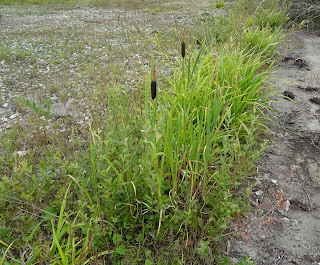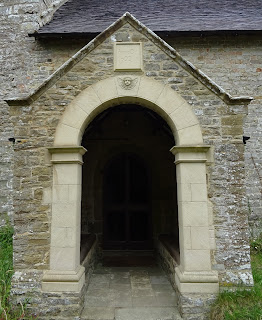Denso Eco Garden, Telford and St. Peter's Church, Edgmond, Wednesday 24th July 2019
O dear!What is it about me and socks?
Yet again I could not find a pair as I unloaded the boot of the car.
I had net, stick, tray, vacuum sampler (in two parts), boots and a bag … but no socks.
And then I remembered.
After last week's lapse I put a spare pair of socks in the first aid compartment in the boot (it seemed an appropriate place).
My feet and boots were saved. Now all I need to do is to remember to put another pair in the compartment for when, inevitably it seems, it happens again.
Sock panic over, as everyone I expected had arrived we ventured onto the site.
The Eco Garden is an area of land around two edges of the Denso site in Telford. A group of the firm's employees persuaded the firm to let them develop what was essentially waste ground into what it is now.
The garden consists of plantation around the edge through which a path has been constructed, a large meadow which was originally destined to be an overflow parking area:
A more formal garden area with raised beds:
And other constructions:
"Wilder" areas:
Pools:
And tree ferns.
If you have some tyres to spare you could also create a feature like this:
The garden is for the employees to enjoy but it is also used to entertain and for educational purposes. It is maintained on a voluntary basis but the firm provides support.
We spent a lot of time in the grassland area and its margin investigating what makes its living there. An early find was a digger wasp:
 |
| Photographs: David Williams |
One insect that we are certain of its identity is Lesne's earwig, Forficula lesnei:
 |
| Photograph: David Williams |
The grassland was a magnet for butterflies. In all we saw eleven species one of which was a Peacock.
 |
| David Williams |
 |
| Photograph: David Williams |
First a newt - it is either a Smooth newt or Palmate newt. It is not a Great-created newt.
 |
| Photograph: David Williams |
 |
| Photograph: David Williams |
And what do you use a pizza oven for?
Yes, I'm sure you could answer that question, cooking pizza.
We were offered generous amounts of a variety of pizzas for lunch in return for our morning efforts, and the offer was graciously accepted and everyone (even the non-pizza eaters) tucked in.
Thank you.
The Denso site offered far more than I had anticipated and half a day was not really long enough to do the site justice. We will return.
On we went to Edgmond and the Church of St. Peter's where we had been invited to look for spiders following a talk our spiderman gave to one of the church's groups.
I'll let you into a secret early … we did not look just for spiders.
On arrival we noted that the churchyard was quite spick and span.
But we did find a small area of grassland that had been allowed to grow.
We met one of the people who look after the church and grounds who told us that many people involved with the church wanted the churchyard to be immaculate. However with persuasion they had been allowed to be less rigorous in their grass-cutting and the above patch was the result. In the longer term I think they hope that more of the churchyard will be allowed to grow providing a greater range of habitats for invertebrates to exploit.
Most of our time was spent looking at the margins of the site which was mainly well developed hedge comprised of a variety of species and the trees that dotted the churchyard.
One of the species in the hedge was box and this yielded a box specialist, the psyllid Spanioneura fonscolobii.
 |
| Photographer: David Williams |
The first was an oak bush cricket:
 |
| Photographer: David Williams |
 |
| Photographer: David Williams |
The afternoon then turned into the afternoon of the ladybird as ten different species were found. Here are photographs of some of them:-
Eighteen-spot ladybird:
 |
| Photograph: David Williams |
Pine ladybird:
 |
| Photograph: David Williams |
 |
| Photograph: David Williams |
 |
| Photograph: David Williams |
My thanks to Denso for allowing us to survey their green space and for providing the much appreciated lunch; to St. Peter's, Edgmond for inviting us to visit their churchyard and to David Williams for allowing me to use his photographs which illuminate this report.













































































